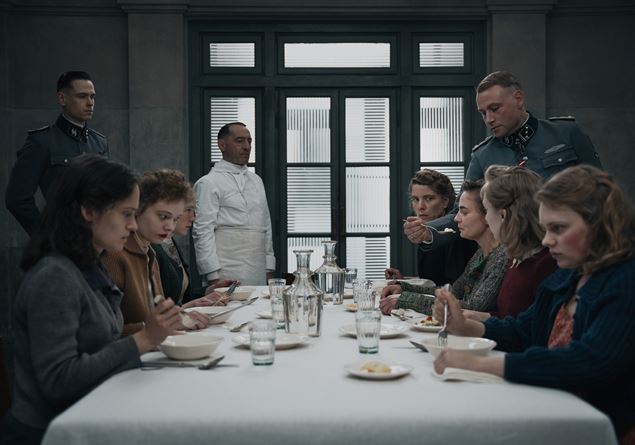Rossella Postorino’s novel Tastingsreleased in 2018, and then winner of the Campiello Prize, also made a story in Italy that seemed to have come out of the imagination of a dystopian author and instead it was one of the many follies planned and conducted by Hitler during the Second World War.
A few years earlier a 95 -year -old German woman, Margot Wölk, had revealed to the German newspaper Der Spiegel A story that had remained until that secret moment. Since 1942 in a village in Eastern Prussia near the so -called “Lupo’s den” one of the general neighborhoods of the Führer, fifteen women forced to taste the courses intended for Hitler’s meals were hired at the end of 1944, in order to intercept any attempts to poison.
Now the Postorino novel (which has been translated into 38 countries) It became a film, directed by Silvio Soldini, in theaters from March 27, With an all -German cast, including the actress Elisa Schlott in the role of the protagonist of the book, Rose Sauer, inspired by Margot Wölk.
Who was Margot Wölk
In the winter of 1941, at 24, Margot Wölk, married to Karl, who started as a soldier immediately after the wedding, abandoned the house of his parents in Berlin, damaged by the bombings of British aviation, to move to a village in Eastern Prussia named Gross-Partsch (today Parcz, in the northeastern Poland) where the mother-in-law lived.
A few kilometers from Gross-Partsch, however, there was the Adolf Hitler headquarters on the eastern front, the Wolfsschaze-or “Lupo’s den” – by Rastenburg: a group of semi -firm bunkers in the forest from which Hitler directed the operations in the Soviet Union until the end of 1944, when it was hastily abandoned due to the advance of the red army.
According to the memories of Wölk, shortly after his arrival, the SS showed up at his door and forced her to follow them. He began his “tasting” period: he was periodically brought together with about ten other women in a barracks from the nearby town of Krausandorf, where some chefs prepared food for Hitler.
The service staff brought vegetables, sauces, sauces, pasta and exotic fruit, placing them in a room with a large wooden table. Then you had to taste it. “There was never meat because Hitler was a vegetarian” recalls Wölk “e The food was good, even very good. But I couldn’t enjoy it».
The SS then brought the dishes to the headquarters, but Hitler never ate before an hour from the tasting (which occurred between 11 and noon) as a further precaution against poisons. Wölk He was woken up every day at 8 by the SS, who shouted them “Margot! Get up! ” From behind the window of his house, and had to be available every day, but was taken to the barracks when Hitler was in Rastenburg, that is, between 1941 and 1944, on average two out of three days. The woman never saw the dictator in person.
Margot Wölk’s family, and the girl herself, was not a Nazi: she had refused to adhere to the youth organization of Hitlerian youth, The League of German girls (Bund Deutscher Mädel) and his father, so he told Margot a Der Spiegel, He had not been promoted at work because he did not have the Nazi party card. Margot’s husband, Karl, was at war and hadn’t sent her news for two years.
After the failure to attack Hitler by a conspiracy led by Colonel von Stauffenberg on 20 July 1944 (told in the film Valchiria operation With Tom Cruise), in which four people were killed – three officers and an stenographer, the safety measures pulled up and tastings were no longer allowed to return home in the evening but were transferred to an abandoned building near the headquarters.
One night, tells Wölk, an SS officer using a scale resting on the facade entered the room where she slept and stuprò. A few weeks later, when the Red Army was a short distance from Rastenburg, The woman managed to abandon the base by climbing on a train to Berlin, With the help of an officer who had taken her aside and told her that the time had come to leave there.
Wölk says that after the war he met again the officer who had put it on the train, who told her that the other tastings remained in Rastenburg had been killed by Soviet soldiers.
In the last months of the war, Wölk remained a long time hidden from a doctor, but returned after some time to Schmargendorf, the area southwest of Berlin where his parents lived. Here It was captured by the Red Army, who held her prisoner for two weeks: a very hard imprisonment, with repeated rapes who submitted her to have children.
In 1946, Margot Wölk gathered to her husband Karl, who had long been a prisoner of war. The couple lived together until his death in 1980. Margot had never talked to anyone of his experience in Hitler’s headquarters, and the opportunity for this revelation in extremis was the interview of a local journalist on life during the war, given his age (95 years).
The woman, perhaps sensing that if she hadn’t done her, that secret would have died with her, decided to reveal the worst years of her life to the reporter.
She died in April 2014, at the age of 96.








